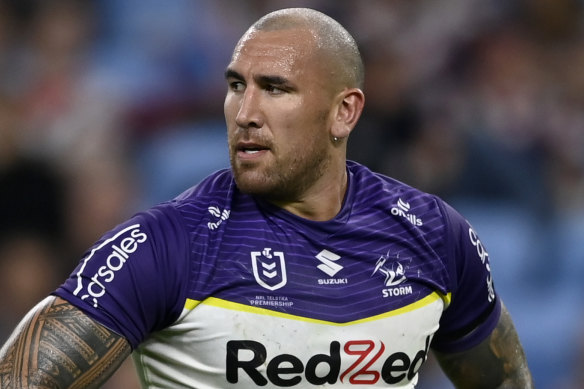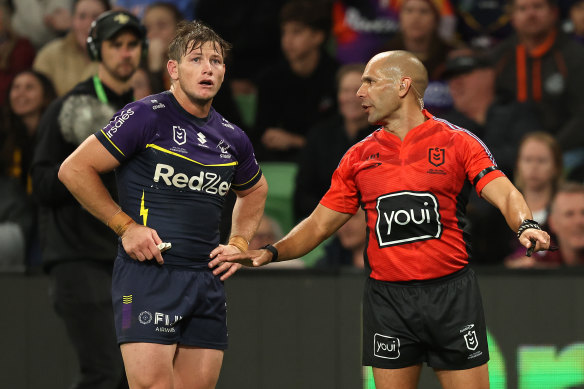This was published 1 year ago
Opinion
NRL rule changes are messing with players’ minds
Roy Masters
Sports ColumnistNRL players are being challenged to process the avalanche of rule changes coming out of Rugby League Central in recent years.
There have been too many new “rule interpretations” – or “policy tweaks”, as the NRL prefers to describe rule changes – for players to comprehend in the high-pressure environment of a game. It is doubly hard for those whose brain circuitry operates without a kill switch. There are times when confrontations cause some players to bypass the brain completely, the impulses travelling directly from eyes to cocked fist.
One of the contentious refereeing incidents in the round seven match between the Roosters and Storm demonstrates the complications of multiple rule changes, demands for NRL black and white interpretations and the muscle/mind memory of experienced players.
Melbourne’s Nelson Asofa-Solomona placed his hand on the back of Eli Katoa as his teammate was surging for a try, but immediately withdrew from the action. The Kiwi international suddenly realised this was a breach of a rule which the NRL had insisted in the off-season it was intent on enforcing. It takes a few hundred milliseconds for a message to travel from neuron to fingertip, perhaps a little longer for a two-metre human.
But big Nelson, playing his first NRL match in 2024, immediately withdrew his hand and himself. A strict black and white interpretation of the so-called “driver” rule would have seen him penalised but the NRL bunker obviously factored in that Katoa continued to move forward unaided and forced the ball for a try, despite three Roosters tackling him.
Roosters coach Trent Robinson certainly believed Asofa-Solomona should have been penalised.

Nelson Asofa-Solomona quickly checked himself when he realised what he was doing against the Roosters.Credit: NRL Photos/Gregg Porteous
“It’s really clear, they (the NRL) came out at the end of the year and if you lend weight to a tackler in a stationary or forward momentum, then it’ll be stopped,” Robinson said at the post-match press conference.
“Or if it’s in a try it’s going to be a penalty.
“It’s really quite simple, he (Asofa-Solomona) runs in from distance, touches his player and Jenko (Roosters player Michael Jennings) and his player scores. Did he lend weight to the play? Yes he did.”
Even years-old rule changes challenge players. In an earlier Storm match, captain Harry Grant, observing a Warriors player on his left at a play-the-ball, deliberately passed the ball from dummy half into him, believing Melbourne would win a penalty because the opposition player was offside.

Harry Grant speaks with referee Ashley Klein.Credit: Getty
Instead, Grant was immediately penalised. He queried the referee, who promptly quoted a rule change which says it an offence to deliberately pass the ball into a defending player at the ruck. Grant asked “since when?” and was told it was a 2018 rule change, brought about by Grant’s predecessor Cameron Smith persistently doing it. In fact, Smith was following another hooker, Michael Ennis, who popularised the practice. So, even six-year-old rule changes take time to register with the smartest of players.
It becomes doubly challenging when a rule change is widely advertised by the NRL and then basically ignored.
Prior to the 2024 season kick-off, the NRL promulgated another two rules which would be strictly enforced: the “downtown” rule and pulling the leg of the tackled player.
However, the early crackdown appears to have been relaxed.
One player, who spoke on the condition of anonymity as he was not permitted by his club to speak about officiating decisions said: “The most bizarre one is the single-leg lift in tackles. It was penalised in the first three to four rounds and now doesn’t get looked at. Confusing.”
The NRL’s own data supports this, with six penalties for leg lifts in the first three rounds, a figure halved over the next four rounds. Headquarters also report two downtown penalties over the first two rounds, zero for the next four rounds before another two in round 7. Champion Data group downtown penalties under “offside”, reporting 13 to date.
NRL head of football Graham Annesley argues we should be comparing the breaches with 2023. “The level of compliance on the downtown rule compared to last year is chalk and cheese,” he said.
“Disruptors are the big issue at the moment,” he added, in reference to the deciding try in the Roosters versus Storm match where Melbourne’s Reimis Smith was accused of impeding Connor Watson taking a high ball. A review indicated that it was Smith who had been impeded from leaping higher when contesting the ball.
Annesley’s focus is on disruptors interfering with catchers of high kicks, including “escorts” who shield the catcher.
However, there is another form of disruption, which the Panthers initiated and other clubs – such as the Roosters and Broncos – have followed. It occurs in what is called the “transition period” from defence to attack. The team fielding the ball from a last-tackle kick sometimes obstructs the chasers, steering them away from their path and therefore allowing their fullback to spear into a gap.
Touch judges have the responsibility of monitoring backplay but they are often too engaged in following the kick.
Nor are these breaches recorded. Champion Data points out that no statistical agency captures cases of illegalities which do not result in a penalty.
If referees penalised every breach on an NRL field, rugby league would be rugby union.
NRL is Live and Free on Channel 9 & 9Now
Sports news, results and expert commentary. Sign up for our Sport newsletter.